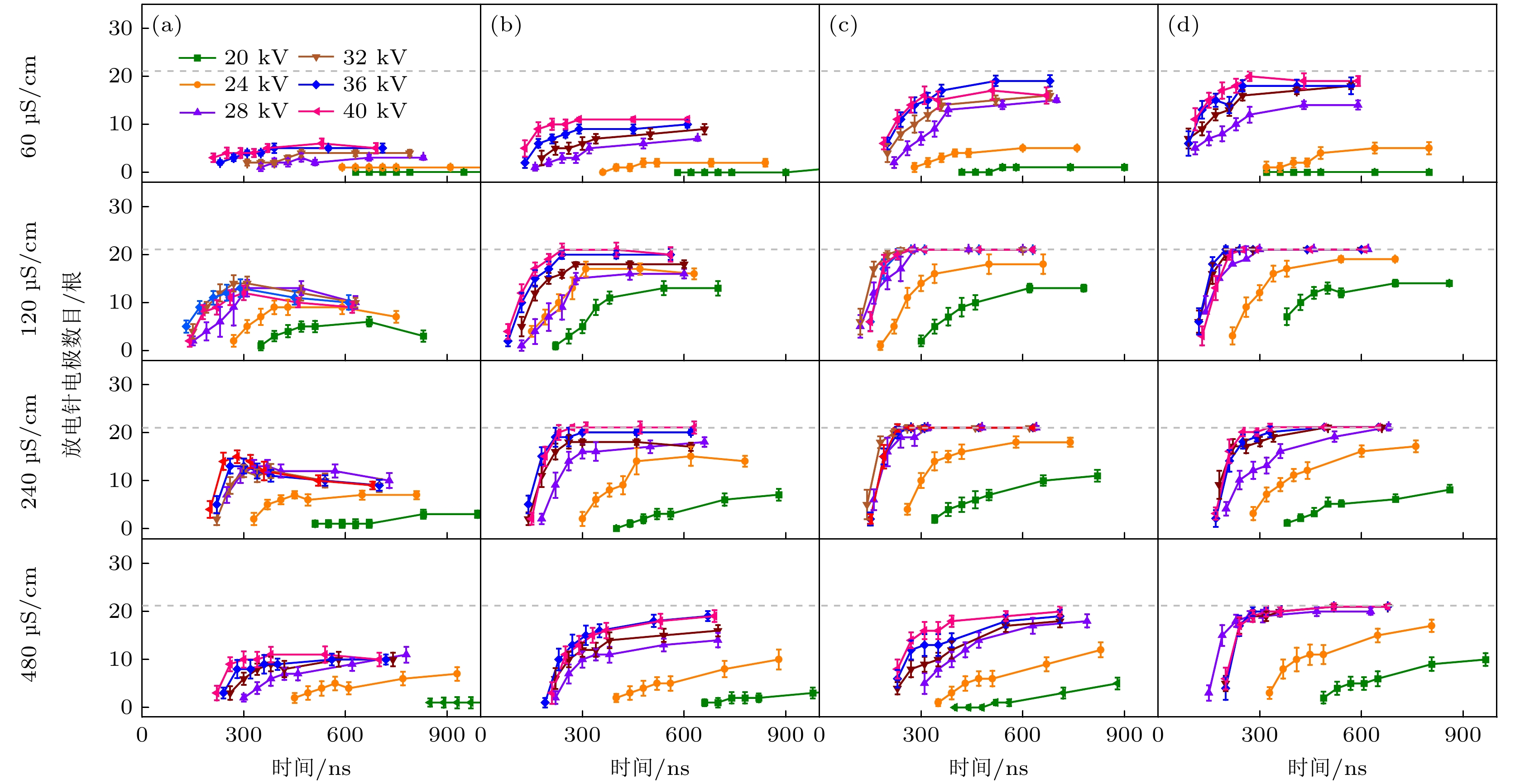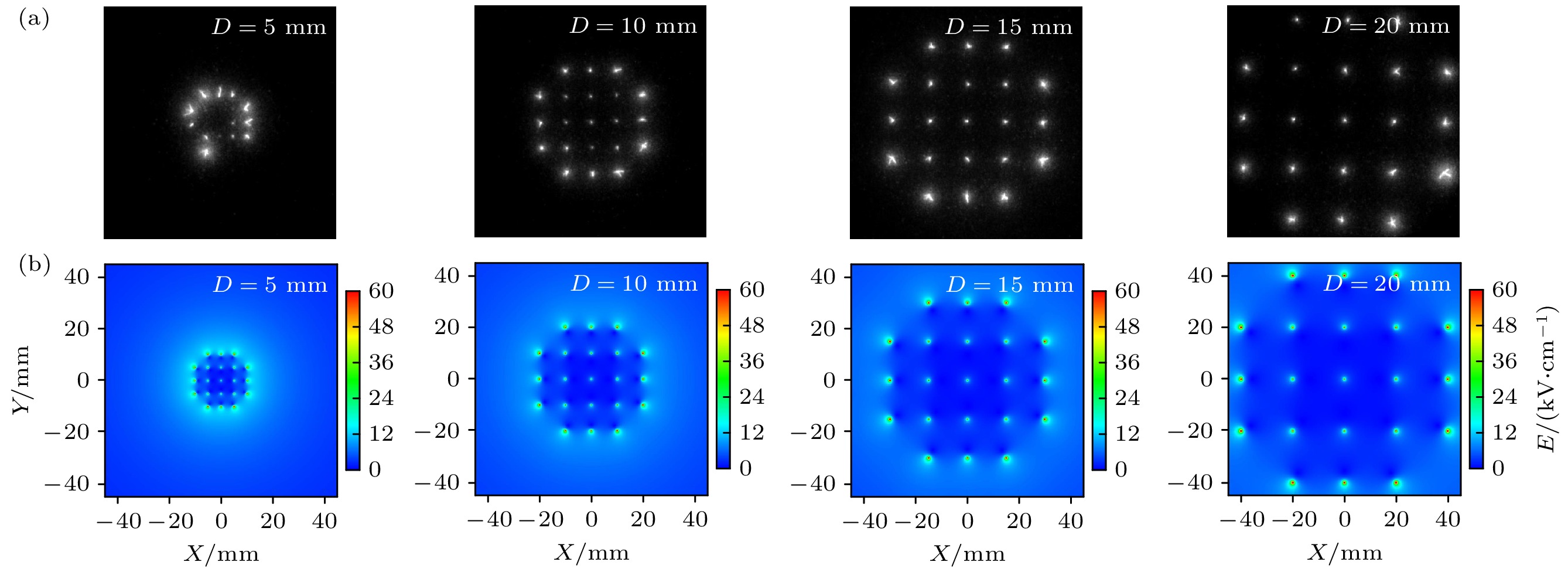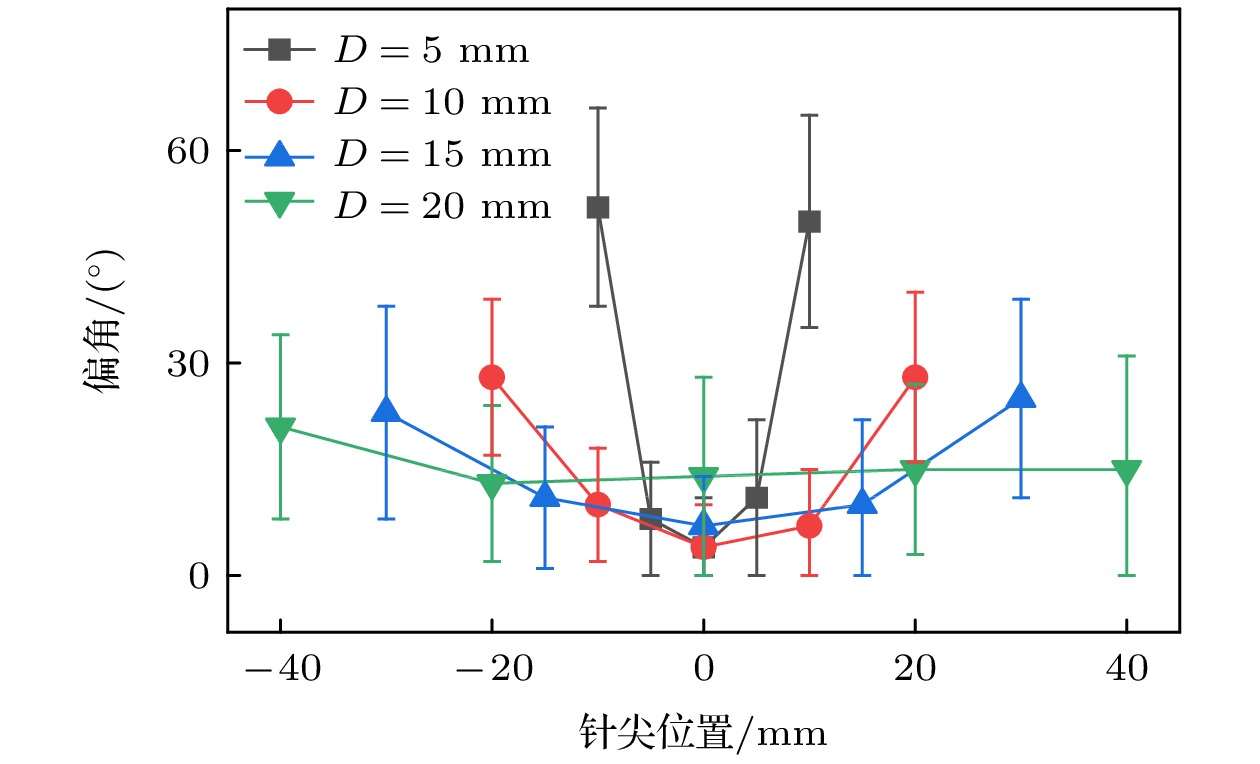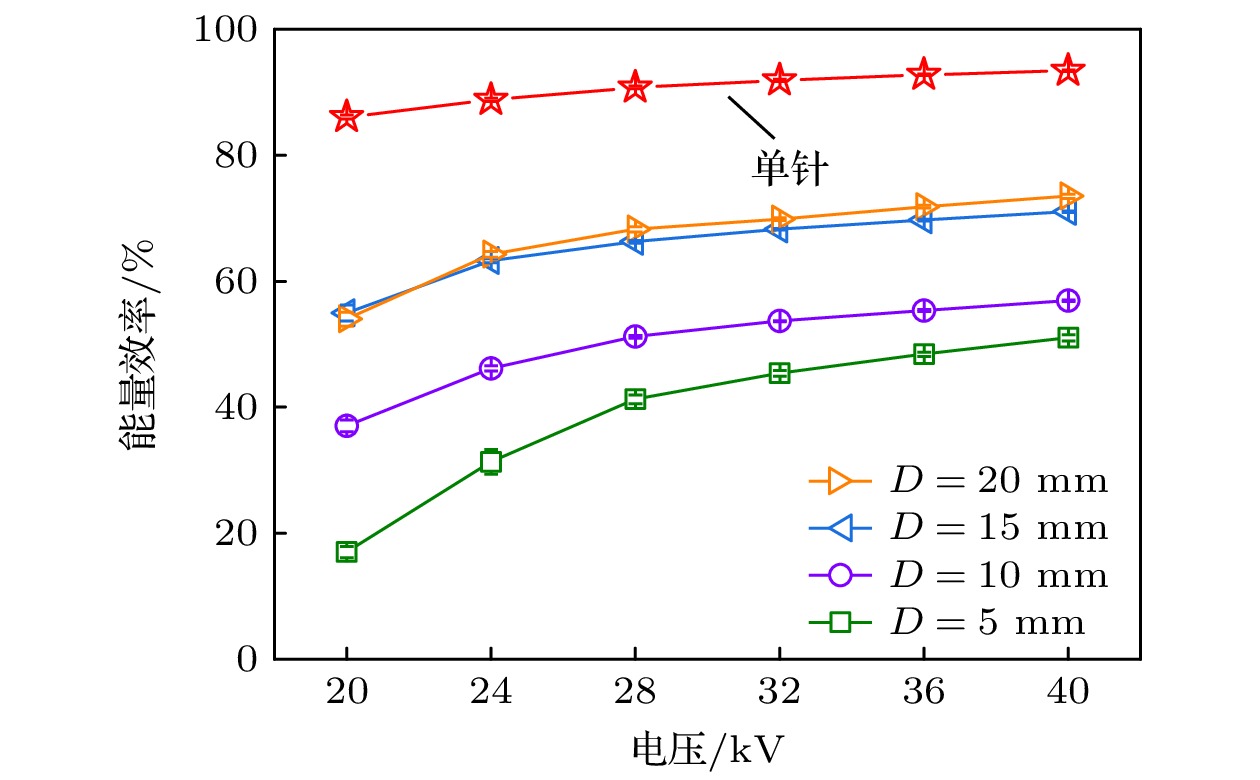-
多针电极结构是实现大体积水下放电的基础性电极结构, 研究其放电基本特性对其他大体积水下放电电极结构的设计具有重要参考意义. 本文构建了一个可安装21根针的多针电极, 利用四分幅超高速相机研究了单个脉冲放电过程中可能放电的针电极数目以及电极阵列边缘和内侧针电极放电形态的差异; 采用COMSOL软件模拟计算了多针电极结构的电场分布, 讨论了电场分布对多针电极放电的影响, 研究了多针电极结构的放电能量效率. 结果发现: 在单个脉冲放电过程中, 21根针电极不是同时发生放电的, 最大放电针电极数目随电压和针针间距的增大而增加. 在同一个脉冲放电过程中, 位于电极阵列边缘的针电极相比于位于阵列内侧的针电极产生的流光丝较长且偏离针电极轴线的偏角相对较大, 这主要是针电极之间电场相互叠加干扰引起的. 针针间距越小, 针电极之间电场的相互叠加干扰越大, 阵列边缘与内侧电极放电形态的差异越大, 放电能量效率越低.The underwater streamer discharge has received extensive attention in the field of environmental protection, because it can generate free radicals and reactive oxygen species directly in water. The multi-needle electrode is a basic electrode configuration for achieving large-volume underwater streamer discharge. Understanding the discharge characteristics of the multi-needle electrode configuration is important for designing the large-volume discharge reactors. In this work, a multi-needle electrode that can assemble 21 needles is employed. The number of anode needles generating a streamer discharge during a single pulsed discharge and the differences in morphological characteristics between the inside and the edge of the electrode array are investigated by using an ultra-high-speed camera system. The electric field distribution of the multi-needle electrode is simulated by using the COMSOL software, and the effect of the electric field distribution on the discharge of multi-needle electrode is also studied. The discharge energy efficiency of the multi-needle electrode configuration is evaluated. It is found that the 21 needles are not discharged simultaneously during a discharge pulse. The number of discharged anode needles gradually increases and then reaches a maximum value (≤21). The maximum number of discharged anode needles during a single discharge pulse increases as the voltage and needle spacing increases. During a single discharge pulse, the filament generated from the needles at the edge of the electrode array grows longer and deviates more largely from the needle axis than that generated from the needles inside the electrode array. Such characteristics are primarily due to the disturbance of the electric field among the 21 needles. As the needle spacing decreases, the disturbance of the electric field among the 21 needles gets stronger, consequently, the discharge morphology differences between the needles at the edge and needles at the inner of the needle array become more significant, and the energy efficiency of the discharge drops remarkably.
-
Keywords:
- streamer discharge in water /
- multi-needle electrode structure /
- distribution of electric field
[1] Cao Y, Qu G Z, Li T F, Jiang N, Wang T C 2018 Plasma Sci. Technol. 20 103001
 Google Scholar
Google Scholar
[2] Lee H D, Kim J O, Chung J W 2015 Desalin. Water Treat. 53 2767
 Google Scholar
Google Scholar
[3] Wang T C, Qu G Z, Pei S Z, Liang D L, Hu S B 2016 Environ. Sci. Pollut. Res. 23 13448
 Google Scholar
Google Scholar
[4] Wen X Q, Wang M, Liu X H 2012 IEEE Trans. Plasma Sci. 40 1089
 Google Scholar
Google Scholar
[5] Kim S D, Jang D I, Lim B J, Lee S B, Mok Y S 2013 Plasma Sci. Technol. 15 659
 Google Scholar
Google Scholar
[6] Hijosa-Valsero M, Molina R, Montràs A, Müller M, Bayona J M 2014 Environ. Technol. Rev. 3 71
 Google Scholar
Google Scholar
[7] Schneider M, Rataj R, Kolb J F, Bláha L 2020 Environ. Pollut. 266 115423
 Google Scholar
Google Scholar
[8] Sakugawa T, Aoki N, Akiyama H, Ishibashi K, Watanabe M, Kouda A, Suematsu K 2014 IEEE Trans. Plasma Sci. 42 794
 Google Scholar
Google Scholar
[9] Schoenbach K H, Joshi R P, Stark R H, Dobbs F C, Beebe S J 2000 IEEE Trans. Dielectr. Electr. Insul. 7 637
 Google Scholar
Google Scholar
[10] Foster J E 2017 Phys. Plasmas 24 055501
 Google Scholar
Google Scholar
[11] Banaschik R, Burchhardt G, Zocher K, Hammerschmidt S, Kolb J F, Weltmann K D 2016 Bioelectrochemistry 112 83
 Google Scholar
Google Scholar
[12] An W, Baumung K, Bluhm H 2007 J. Appl. Phys. 101 053302
 Google Scholar
Google Scholar
[13] Locke B R, Thagard S M 2012 Plasma Chem. Plasma P. 32 875
 Google Scholar
Google Scholar
[14] Lesaint O 2016 J. Phys. D: Appl. Phys. 49 144001
 Google Scholar
Google Scholar
[15] Ceccato P, Guaitella O, Shaper L, Graham B, Rousseau A 2009 IEEE Pulsed Power Conference Washington D. C. , USA, June 28–July 2, 2009 p866
[16] Fujita H, Kanazawa S, Ohtani K, Komiya A, Kaneko T, Sato T 2014 J. Appl. Phys. 116 213301
 Google Scholar
Google Scholar
[17] Fujita H, Kanazawa S, Ohtani K, Komiya A, Sato T 2013 J. Appl. Phys. 113 113304
 Google Scholar
Google Scholar
[18] Katsuki S, Tanaka K, Fudamoto T, Namihira T, Akiyama H, Bluhm H 2006 Jpn. J. Appl. Phys. 45 239
 Google Scholar
Google Scholar
[19] Marinov I, Starikovskaia S, Rousseau A 2014 J. Phys. D: Appl. Phys. 47 224017
 Google Scholar
Google Scholar
[20] Katsuki S, Akiyama H, Abou-Ghazala A, Schoenbach K H 2002 IEEE Trans. Dielectr. Electr. Insul. 9 498
 Google Scholar
Google Scholar
[21] Wen X Q, Liu G S, Ding Z F 2012 IEEE Trans. Plasma Sci. 40 438
 Google Scholar
Google Scholar
[22] Wen X Q, Liu G S, Ding Z F 2011 IEEE Trans. Plasma Sci. 39 1758
 Google Scholar
Google Scholar
[23] Kolb J F, Joshi R P, Xiao S, Schoenbach K H 2008 J. Phys. D: Appl. Phys. 41 234007
 Google Scholar
Google Scholar
[24] Vanraes P, Bogaerts A 2018 Appl. Phys. Rev. 5 031103
 Google Scholar
Google Scholar
[25] Sharbaugh A H, Devins J C, Rzad S J 1978 IEEE Trans. Electr. Insul. EI-13 249
 Google Scholar
Google Scholar
[26] Jones H M, Kunhardt E E 1994 IEEE Trans. Dielectr. Electr. Insul. 1 1016
 Google Scholar
Google Scholar
[27] Kunhardt E E 1991 Phys. Rev. B 44 4235
 Google Scholar
Google Scholar
[28] Joshi R P, Qian J, Zhao G, Kolb J, Schoenbach K H, Schamiloglu E, Gaudet J 2004 J. Appl. Phys. 96 5129
 Google Scholar
Google Scholar
[29] Shneider M N, Pekker M, Fridman A 2012 IEEE Trans. Dielectr. Electr. Insul. 19 1579
 Google Scholar
Google Scholar
[30] Starikovskiy A, Yang Y, Cho Y I, Fridman A 2011 Plasma Sources Sci. Technol. 20 024003
 Google Scholar
Google Scholar
[31] Marinov I, Guaitella O, Rousseau A, Starikovskaia S M 2013 Plasma Sources Sci. Technol. 22 042001
 Google Scholar
Google Scholar
[32] Banaschik R, Lukes P, Jablonowski H, Hammer M U, Weltmann K D, Kolb J F 2015 Water Res. 84 127
 Google Scholar
Google Scholar
[33] Luke P, Clupek M, Sunka P, Babick V, Janda V 2002 Czech. J. Phys. 52 800
[34] Malik M A, Minamitani Y, Xiao S, Kolb J F, Schoenbach K H 2005 IEEE Trans. Plasma Sci. 33 490
 Google Scholar
Google Scholar
[35] Wen X Q, Liu G S, Ding Z F 2010 IEEE Trans. Plasma Sci. 38 3330
 Google Scholar
Google Scholar
[36] Sugiarto A T, Sato M, Ohshima T, Skalny J D 2002 J. Adv. Oxid. Technol. 5 211
 Google Scholar
Google Scholar
[37] Sugiarto A T, Ohshima T, Sato M 2002 Thin Solid Films 407 174
 Google Scholar
Google Scholar
[38] Lisitsyn I V, Nomiyama H, Katsuki S, Akiyama H 1999 Rev. Sci. Instrum. 70 3457
 Google Scholar
Google Scholar
[39] Wang H J, Li J, Quan X 2006 J. Electrostat. 64 416
 Google Scholar
Google Scholar
[40] Lukes P, Clupek M, Babicky V, Sunka P 2008 IEEE Trans. Plasma Sci. 36 1146
 Google Scholar
Google Scholar
[41] Šunka P 2001 Phys. Plasmas 8 2587
 Google Scholar
Google Scholar
[42] Zhu T Y, Zhang Q G, Shi X Y, Li Z, Yang L J 2008 IEEE Trans. Plasma Sci. 36 237
 Google Scholar
Google Scholar
[43] Zhu T Y, Yang L J, Jia Z J, Zhang Q G 2008 J. Appl. Phys. 104 113302
 Google Scholar
Google Scholar
[44] Hartmann W, Roemheld M, Rohde K D, Spiess F J 2009 IEEE Trans. Dielectr. Electr. Insul. 16 1061
 Google Scholar
Google Scholar
[45] Wang H J, Li J, Quan X, Wu Y 2008 Appl. Catal. B Environ. 83 72
 Google Scholar
Google Scholar
[46] 郭沛 2023 学士学位论文 (大连: 大连理工大学)
Guo P 2023 B. S. Thesis (Dalian: Dalian University of Technology
[47] 佟云颢 2021 学士学位论文 (大连: 大连理工大学)
Tong Y H 2021 B. S. Thesis (Dalian: Dalian University of Technology
[48] Wang L R, Wen X Q, Yang Y T, Wang X 2023 J. Appl. Phys. 134 013302
 Google Scholar
Google Scholar
-
图 3 多针电极放电时间演化图像(15 mm, 60 µS/cm, 28 kV) (a)曝光时间40 ns, 相邻两幅图像的时间间隔40 ns; (b)曝光时间40 ns, 相邻两幅图像的时间间隔160 ns, 图中所标的时间是相对高压脉冲起始点的时间
Fig. 3. Temporal evolution of multi-needle underwater streamer discharge (15 mm, 60 µS/cm, 28 kV): (a) 40 ns exposure, 40 ns interval; (b) 40 ns exposure, 160 ns interval. The time marked in the figure is the time to the start of the high-voltage pulse.
图 4 单个脉冲放电过程中不同针针间距D、水电导率和外加电压下放电针电极数目随时间的变化 (a) D = 5 mm; (b) D = 10 mm; (c) D = 15 mm; (d) D = 20 mm. 图(b), (c), (d)和图(a)图例相同, 灰色虚线表示21根针电极
Fig. 4. Temporal evolution of the number of discharged needle electrodes during one discharge pulse at different needle spacings, water conductivities and applied voltages: (a) D = 5 mm; (b) D = 10 mm; (c) D = 15 mm; (d) D = 20 mm. Legends of panels (b), (c) and (d) are the same as that denoted in panel (a), and the gray dashed line indicates 21 needle electrodes.
图 5 针针间距、水电导率和外加电压对单个脉冲放电过程中最大放电针电极数目的影响 (a) 水电导率60 µS/cm; (b) 水电导率120 µS/cm; (c) 水电导率240 µS/cm; (d) 水电导率480 µS/cm
Fig. 5. Influence of the needle spacing, the water conductivity and the applied voltage on the maximum number of discharged needles: (a) Water conductivity is 60 µS/cm; (b) 120 µS/cm; (c) 240 µS/cm; (d) 480 µS/cm.
图 6 (a)不同针针间距下多针电极阵列中边缘电极与内侧电极放电形态差异(40 kV, 240 µS/cm); (b)不同针针间距下多针电极阵列正面的电场分布图(40 kV)
Fig. 6. (a) Differences in morphology of the inner and outside needles at different needle spacings (40 kV, 240 µS/cm); (b) distribution of the electric field of the multi-needle electrode (front view) at different needle spacings (40 kV).
图 8 (a) 不同针针间距下5针电极水下流光放电的侧面发光图像(40 kV, 240 µS/cm); (b)不同针针间距下5针电极的侧面电力线分布图(40 kV)
Fig. 8. (a) Lateral emission images of underwater streamer discharge generated from a 5-needle array at different needle spacings (40 kV, 240 µS/cm); (b) electric fluxline of a 5-needle array at different needle spacings (40 kV).
-
[1] Cao Y, Qu G Z, Li T F, Jiang N, Wang T C 2018 Plasma Sci. Technol. 20 103001
 Google Scholar
Google Scholar
[2] Lee H D, Kim J O, Chung J W 2015 Desalin. Water Treat. 53 2767
 Google Scholar
Google Scholar
[3] Wang T C, Qu G Z, Pei S Z, Liang D L, Hu S B 2016 Environ. Sci. Pollut. Res. 23 13448
 Google Scholar
Google Scholar
[4] Wen X Q, Wang M, Liu X H 2012 IEEE Trans. Plasma Sci. 40 1089
 Google Scholar
Google Scholar
[5] Kim S D, Jang D I, Lim B J, Lee S B, Mok Y S 2013 Plasma Sci. Technol. 15 659
 Google Scholar
Google Scholar
[6] Hijosa-Valsero M, Molina R, Montràs A, Müller M, Bayona J M 2014 Environ. Technol. Rev. 3 71
 Google Scholar
Google Scholar
[7] Schneider M, Rataj R, Kolb J F, Bláha L 2020 Environ. Pollut. 266 115423
 Google Scholar
Google Scholar
[8] Sakugawa T, Aoki N, Akiyama H, Ishibashi K, Watanabe M, Kouda A, Suematsu K 2014 IEEE Trans. Plasma Sci. 42 794
 Google Scholar
Google Scholar
[9] Schoenbach K H, Joshi R P, Stark R H, Dobbs F C, Beebe S J 2000 IEEE Trans. Dielectr. Electr. Insul. 7 637
 Google Scholar
Google Scholar
[10] Foster J E 2017 Phys. Plasmas 24 055501
 Google Scholar
Google Scholar
[11] Banaschik R, Burchhardt G, Zocher K, Hammerschmidt S, Kolb J F, Weltmann K D 2016 Bioelectrochemistry 112 83
 Google Scholar
Google Scholar
[12] An W, Baumung K, Bluhm H 2007 J. Appl. Phys. 101 053302
 Google Scholar
Google Scholar
[13] Locke B R, Thagard S M 2012 Plasma Chem. Plasma P. 32 875
 Google Scholar
Google Scholar
[14] Lesaint O 2016 J. Phys. D: Appl. Phys. 49 144001
 Google Scholar
Google Scholar
[15] Ceccato P, Guaitella O, Shaper L, Graham B, Rousseau A 2009 IEEE Pulsed Power Conference Washington D. C. , USA, June 28–July 2, 2009 p866
[16] Fujita H, Kanazawa S, Ohtani K, Komiya A, Kaneko T, Sato T 2014 J. Appl. Phys. 116 213301
 Google Scholar
Google Scholar
[17] Fujita H, Kanazawa S, Ohtani K, Komiya A, Sato T 2013 J. Appl. Phys. 113 113304
 Google Scholar
Google Scholar
[18] Katsuki S, Tanaka K, Fudamoto T, Namihira T, Akiyama H, Bluhm H 2006 Jpn. J. Appl. Phys. 45 239
 Google Scholar
Google Scholar
[19] Marinov I, Starikovskaia S, Rousseau A 2014 J. Phys. D: Appl. Phys. 47 224017
 Google Scholar
Google Scholar
[20] Katsuki S, Akiyama H, Abou-Ghazala A, Schoenbach K H 2002 IEEE Trans. Dielectr. Electr. Insul. 9 498
 Google Scholar
Google Scholar
[21] Wen X Q, Liu G S, Ding Z F 2012 IEEE Trans. Plasma Sci. 40 438
 Google Scholar
Google Scholar
[22] Wen X Q, Liu G S, Ding Z F 2011 IEEE Trans. Plasma Sci. 39 1758
 Google Scholar
Google Scholar
[23] Kolb J F, Joshi R P, Xiao S, Schoenbach K H 2008 J. Phys. D: Appl. Phys. 41 234007
 Google Scholar
Google Scholar
[24] Vanraes P, Bogaerts A 2018 Appl. Phys. Rev. 5 031103
 Google Scholar
Google Scholar
[25] Sharbaugh A H, Devins J C, Rzad S J 1978 IEEE Trans. Electr. Insul. EI-13 249
 Google Scholar
Google Scholar
[26] Jones H M, Kunhardt E E 1994 IEEE Trans. Dielectr. Electr. Insul. 1 1016
 Google Scholar
Google Scholar
[27] Kunhardt E E 1991 Phys. Rev. B 44 4235
 Google Scholar
Google Scholar
[28] Joshi R P, Qian J, Zhao G, Kolb J, Schoenbach K H, Schamiloglu E, Gaudet J 2004 J. Appl. Phys. 96 5129
 Google Scholar
Google Scholar
[29] Shneider M N, Pekker M, Fridman A 2012 IEEE Trans. Dielectr. Electr. Insul. 19 1579
 Google Scholar
Google Scholar
[30] Starikovskiy A, Yang Y, Cho Y I, Fridman A 2011 Plasma Sources Sci. Technol. 20 024003
 Google Scholar
Google Scholar
[31] Marinov I, Guaitella O, Rousseau A, Starikovskaia S M 2013 Plasma Sources Sci. Technol. 22 042001
 Google Scholar
Google Scholar
[32] Banaschik R, Lukes P, Jablonowski H, Hammer M U, Weltmann K D, Kolb J F 2015 Water Res. 84 127
 Google Scholar
Google Scholar
[33] Luke P, Clupek M, Sunka P, Babick V, Janda V 2002 Czech. J. Phys. 52 800
[34] Malik M A, Minamitani Y, Xiao S, Kolb J F, Schoenbach K H 2005 IEEE Trans. Plasma Sci. 33 490
 Google Scholar
Google Scholar
[35] Wen X Q, Liu G S, Ding Z F 2010 IEEE Trans. Plasma Sci. 38 3330
 Google Scholar
Google Scholar
[36] Sugiarto A T, Sato M, Ohshima T, Skalny J D 2002 J. Adv. Oxid. Technol. 5 211
 Google Scholar
Google Scholar
[37] Sugiarto A T, Ohshima T, Sato M 2002 Thin Solid Films 407 174
 Google Scholar
Google Scholar
[38] Lisitsyn I V, Nomiyama H, Katsuki S, Akiyama H 1999 Rev. Sci. Instrum. 70 3457
 Google Scholar
Google Scholar
[39] Wang H J, Li J, Quan X 2006 J. Electrostat. 64 416
 Google Scholar
Google Scholar
[40] Lukes P, Clupek M, Babicky V, Sunka P 2008 IEEE Trans. Plasma Sci. 36 1146
 Google Scholar
Google Scholar
[41] Šunka P 2001 Phys. Plasmas 8 2587
 Google Scholar
Google Scholar
[42] Zhu T Y, Zhang Q G, Shi X Y, Li Z, Yang L J 2008 IEEE Trans. Plasma Sci. 36 237
 Google Scholar
Google Scholar
[43] Zhu T Y, Yang L J, Jia Z J, Zhang Q G 2008 J. Appl. Phys. 104 113302
 Google Scholar
Google Scholar
[44] Hartmann W, Roemheld M, Rohde K D, Spiess F J 2009 IEEE Trans. Dielectr. Electr. Insul. 16 1061
 Google Scholar
Google Scholar
[45] Wang H J, Li J, Quan X, Wu Y 2008 Appl. Catal. B Environ. 83 72
 Google Scholar
Google Scholar
[46] 郭沛 2023 学士学位论文 (大连: 大连理工大学)
Guo P 2023 B. S. Thesis (Dalian: Dalian University of Technology
[47] 佟云颢 2021 学士学位论文 (大连: 大连理工大学)
Tong Y H 2021 B. S. Thesis (Dalian: Dalian University of Technology
[48] Wang L R, Wen X Q, Yang Y T, Wang X 2023 J. Appl. Phys. 134 013302
 Google Scholar
Google Scholar
计量
- 文章访问数: 3268
- PDF下载量: 149
- 被引次数: 0














 下载:
下载:










